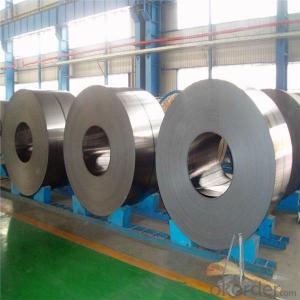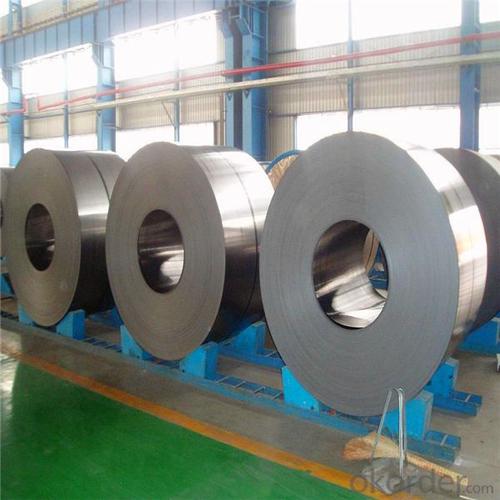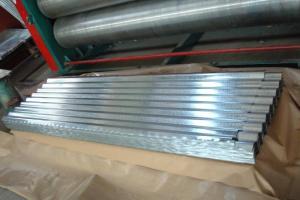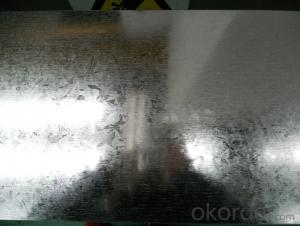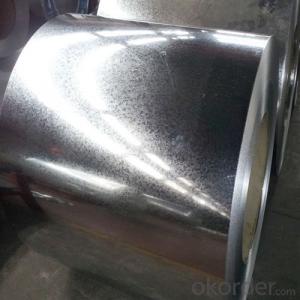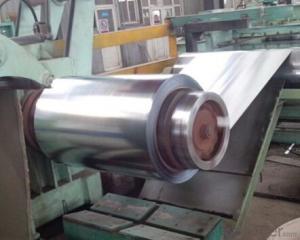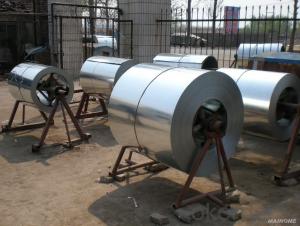Cold Rolled/Hot Dipped Galvanized Steel Coil
- Loading Port:
- China main port
- Payment Terms:
- TT OR LC
- Min Order Qty:
- 23 m.t.
- Supply Capability:
- 50000 m.t./month
OKorder Service Pledge
OKorder Financial Service
You Might Also Like
Specification
| Thickness | 0.12mm-3.5mm |
| Thickness tolerance | ±0.02mm |
| Width | 600--1500mm |
| Width tolerance | ±2mm |
| Length | 1-6m or in coil |
| Zinc coating | 40g/m2-275g/m2 |
| Types | Commercial / Drawing / Deep Drawing / Structural quality |
| Quality | Soft or hard quality |
| Standard | ASTM, AISI, DIN, GB,JIS |
| Material | SGCC, DX51D,DX52D, DX53D,SGCD , Q195, Q235, SGHC, DX54D, S350GD, S450GD, S550GD, etc |
| Spangle State | Regular spangle, small spangle, big spangle, non-spangle |
| Surface treatment | chromed / oiled/slightly oiled/ dry/ anti-fingerprint etc |
| Coil weight | 3-8ton or up to you |
| Coil ID: | 508 /610mm |
| Packing | Standard exportation packing |
| Min order | As per specification |
Product Picture
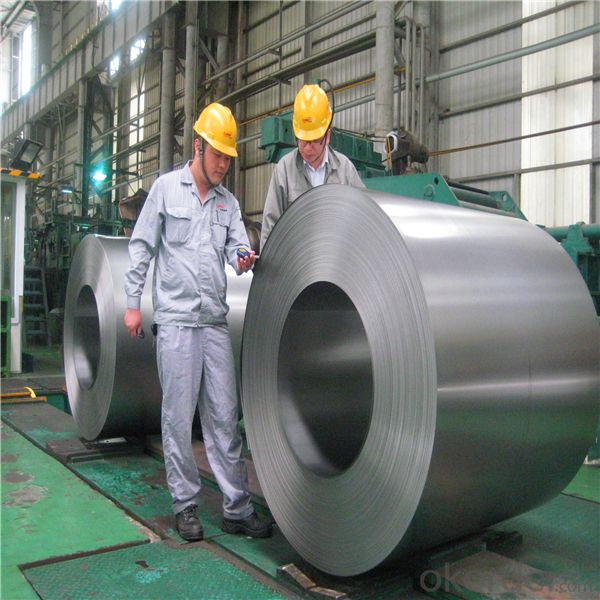

FAQ
1. Q: What's the MOQ?
A: Our MOQ is 25mt.
2. Q: What's the delivery time?
A: It will take about 30 days after TT or L/C.
3. Q: What is the payment terms?
A: T/T, L/C at sight
4. Q: How does your factory carry out quality control?
A: We attach great importance to quality control.Every part of our products has its own QC.
5. Q: What certificate do you have?
A: We have SGS, ISO9001 etc. Also we can apply any certificate if you need if the qty is OK.
- Q: How are steel coils coated?
- Steel coils are typically coated through a process known as coil coating, which involves applying a protective layer to the surface of the steel. This is done by passing the coil through a series of rollers that apply the coating material evenly across the entire surface. The coating can be applied using various methods such as roll coating, spray coating, or electrostatic coating, depending on the desired finish and properties. The coated steel coils are then cured or baked to ensure the coating adheres properly and provides the desired level of protection and durability.
- Q: How are steel coils used in the production of steel cables?
- Steel coils are used in the production of steel cables by being uncoiled and straightened, then fed into a machine that twists and braids them together to create the cable.
- Q: How are steel coils used in the manufacturing of medical equipment?
- Steel coils are commonly used in the manufacturing of medical equipment to shape and form various components such as frames, supports, and brackets. These coils are often cut, bent, and welded to create the necessary structures that provide strength and stability to the equipment. Additionally, steel coils may be used in the production of springs, which are essential for medical devices that require controlled movement or pressure. Overall, steel coils play a crucial role in enhancing the durability, functionality, and safety of medical equipment.
- Q: I'm just wondering what the best steel would be for an edc/hunting knife that could put up with alot of abuse.
- i have been a chef for 10 years now and have always had an obsesive composion with my knifes being dual. i hate it. after spending $100's of dollars on knifes i have found a couple of things to be key. where the knife comes from is important. japan and sweden are a notch above the rest. this just has to do with there tradition of fine craftmanship and pride in quality knife making that goes back 1000's of years. the thickness of the blade is important. the thinner the better. and the blade angel most knifes are around 20 degrees but less is better. it makes them easier to sharpen. and don't be fooled knifes need to be hoaned everyday of use the is no such thing as a forever sharp knife. at least not for a chef. so having said that. the best knifes on the market for quality and price are global, mizuno, mac, and the ones i use calphalon katana. investing in a good diamond steel is just as important i use fury fingers by ozzi tech. good luck i wish i had a girlfriend like you.
- Q: Can steel coils be coated with anti-corrosive substances?
- Yes, steel coils can be coated with anti-corrosive substances such as zinc, paint, or polymer coatings to protect them from rust and corrosion. These coatings act as a barrier between the steel surface and the surrounding environment, preventing contact with moisture and corrosive elements.
- Q: I plan to buy a bushcraft knife ..The blade made up by damascus steel.My question is ,is damascus steel is very strong ?
- So, there isn't a good answer to your question, because Damascus doesn't describe the actual materials properties of the steel, rather the mechanical construct of the steel. For example: A very common Damascus steel is to layer L6 with 1080 high carbon steel and forge weld the layers together to make a blank, anneal it, then grind it into your blade and heat treat it. (Massive over simplification) That type of Damascus steel is going to be a bit softer than one of the super high carbon exotics, but will be tougher in terms of ability to flex without taking a set, and not chipping out if the edge hits something hard. (assuming it is heat treated well) - edge between RC56 - 58 typically. Another common Damascus steel is layers of VG-10 steel and VG-1 steel also welded together, with the billet then annealed, ground, and heat treated. In this case, because you are using stainless steels you will get a much harder edge - RC 60 - 62 typically. It will have better toughness than plain VG-10, but certainly nowhere near what you can get out of L6 or 52100 or something of that sort. Generally, for a bushcraft knife you typically want something like the first type of Damascus because you are looking for a more all purpose tool, and typically a larger knife. The only problem is that in the bush the first types of steel typically rust. The second type is made up of stain resistant steels and will hold up better. So, this brings me around to - why exactly do you want a Damascus blade on your knife? Are you already looking at one you like? Thinkingblade
- Q: More specifically steel wire (around 1/8 diameter). I'm doing a science fair project where I'm testing if concrete encased in steel has more fire resistance than steel by itself. However, I have no idea what the dimensions of concrete encased steel is so I can't scale down. And if I did have the dimensions I wouldn't know how to encase it around the steel wire (do I just poor concrete over it (heck I've never even used concrete)? Thanks for any help.
- Yeah, just pour the concrete over it, but make sure the steel is in the middle of the concrete (I'm sure you can figure out a way to do this). What you're thinking of is called steel rebar.
- Q: and what are the four main elements in STAINLESS steel? x
- Very high carbon steel (0.96 to 2.11%) is hard and not very ductile (difficult to mold or shape). It is also difficult to weld, but has the lowest melting point. As the carbon content is reduced, the steel becomes softer, more ductile and melts at a higher temperature. Stainless steel is an alloy of Iron, Carbon, Chromium. The fourth element would depend upon the grade of steel, but Nickel is probably the most common.
- Q: I read that contrary to popular belief, today's folded steel swords are only made that way for tradition and cosmetics. In the past steel was very impure and therefore had to be folded in order to make a good sword. Today's steel manufacturing provides very pure steel and so folding the metal only makes it look nicer, but does nothing to improve the function of the blade.What do you think of this?
- Folding Sword
- Q: What are the applications of steel coils in automotive manufacturing?
- Steel coils have various applications in automotive manufacturing. They are used primarily for the production of car bodies, as well as for other components such as doors, hoods, fenders, and trunk lids. Steel coils provide high strength, durability, and formability, making them suitable for creating robust and safe vehicles. Additionally, they offer excellent resistance to corrosion and can be easily molded into complex shapes, ensuring the desired design aesthetics and functionality.
Send your message to us
Cold Rolled/Hot Dipped Galvanized Steel Coil
- Loading Port:
- China main port
- Payment Terms:
- TT OR LC
- Min Order Qty:
- 23 m.t.
- Supply Capability:
- 50000 m.t./month
OKorder Service Pledge
OKorder Financial Service
Similar products
Hot products
Hot Searches
Related keywords
